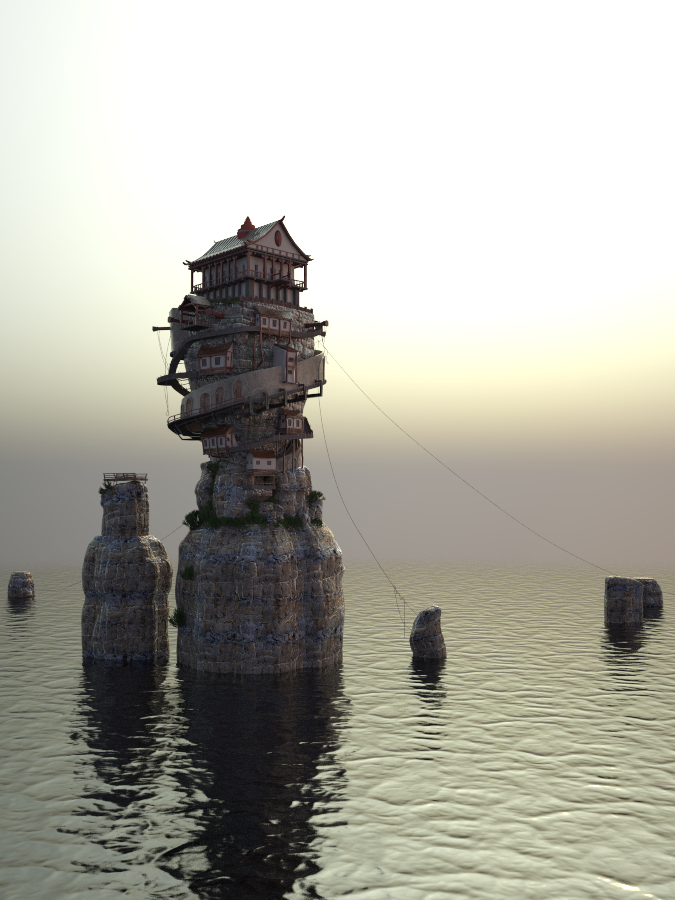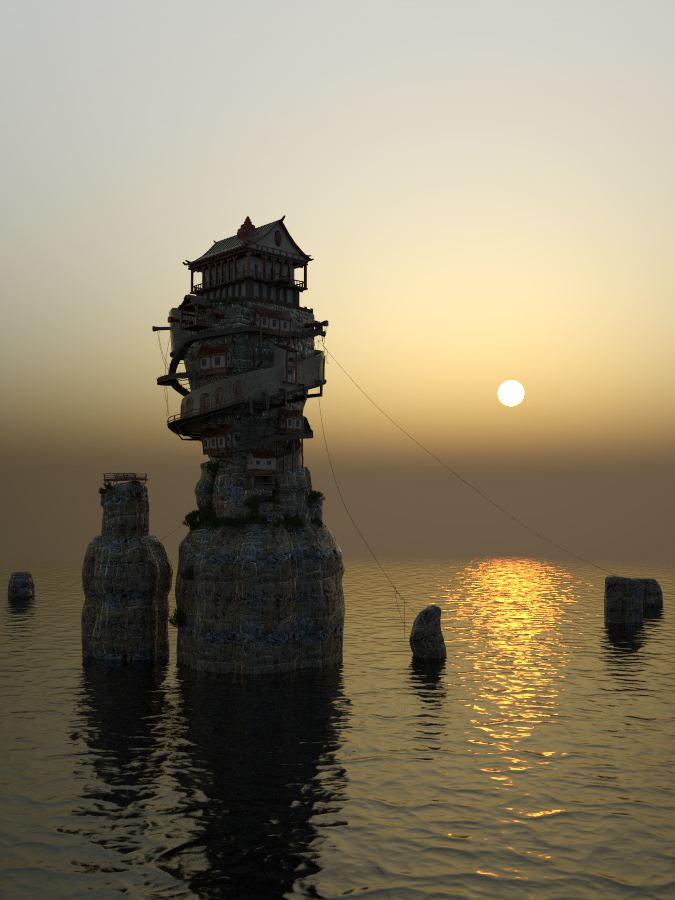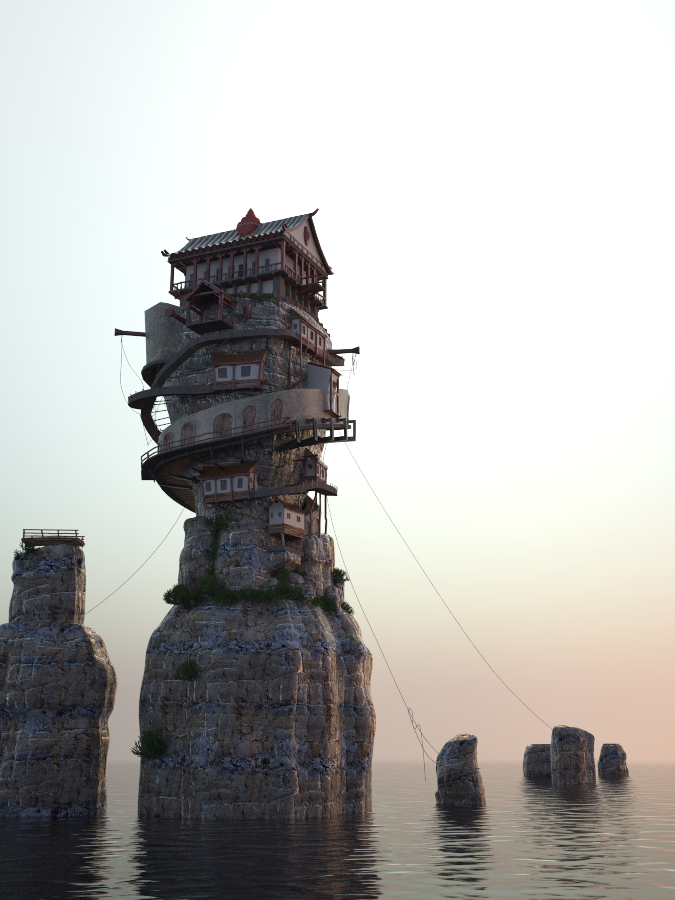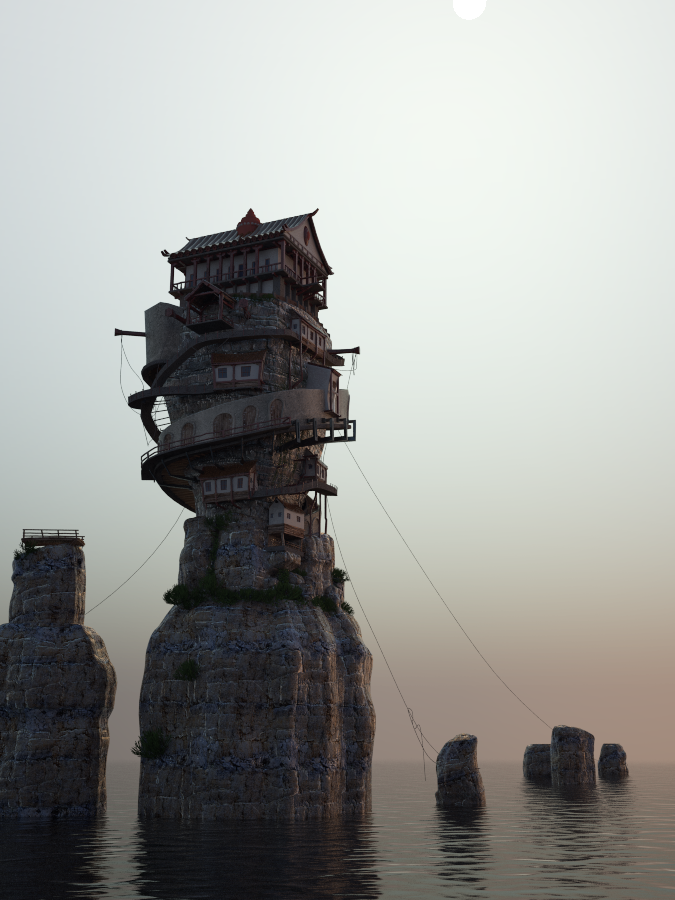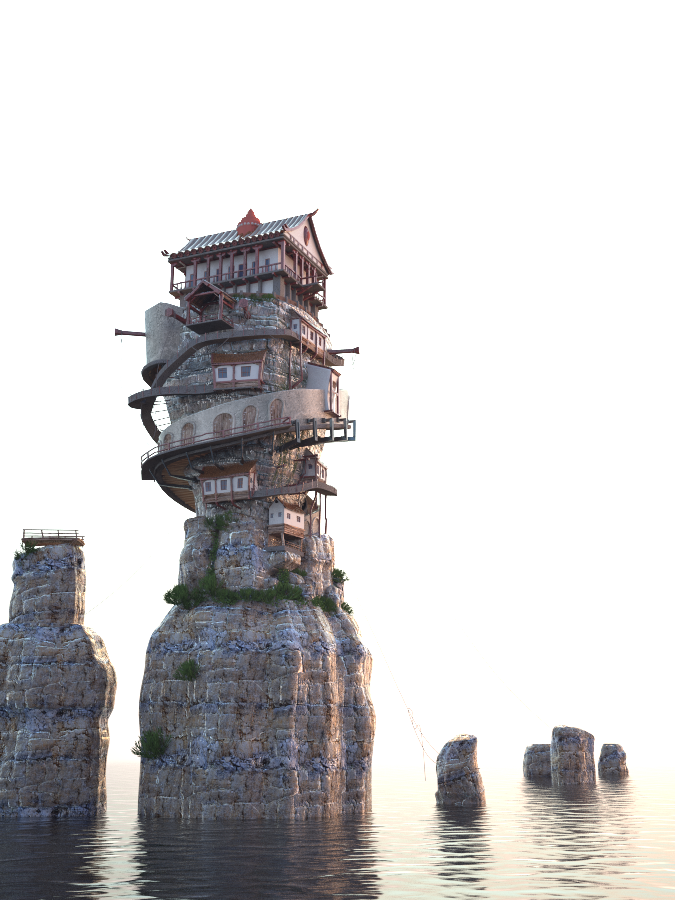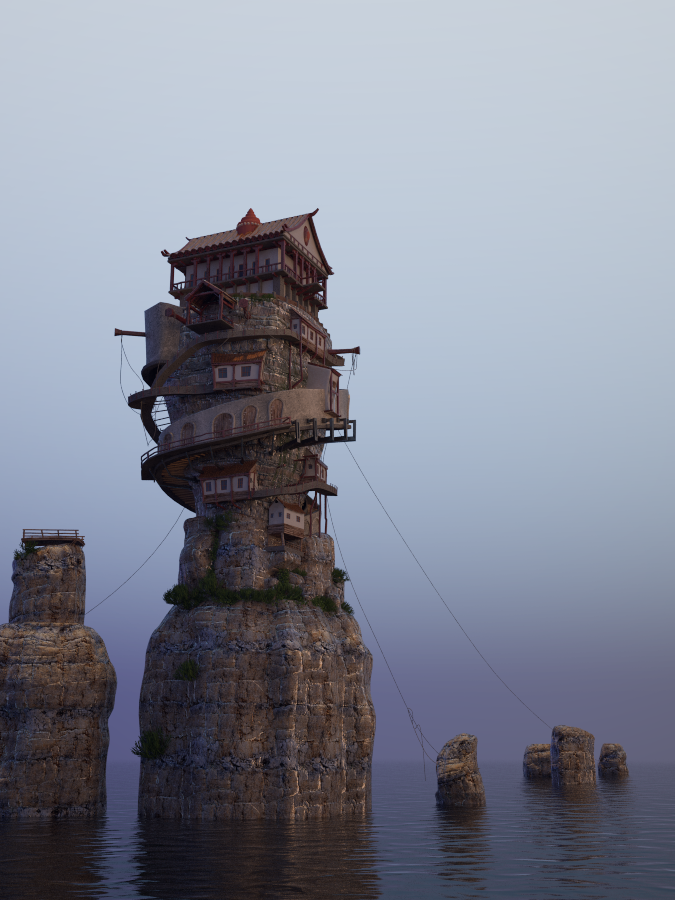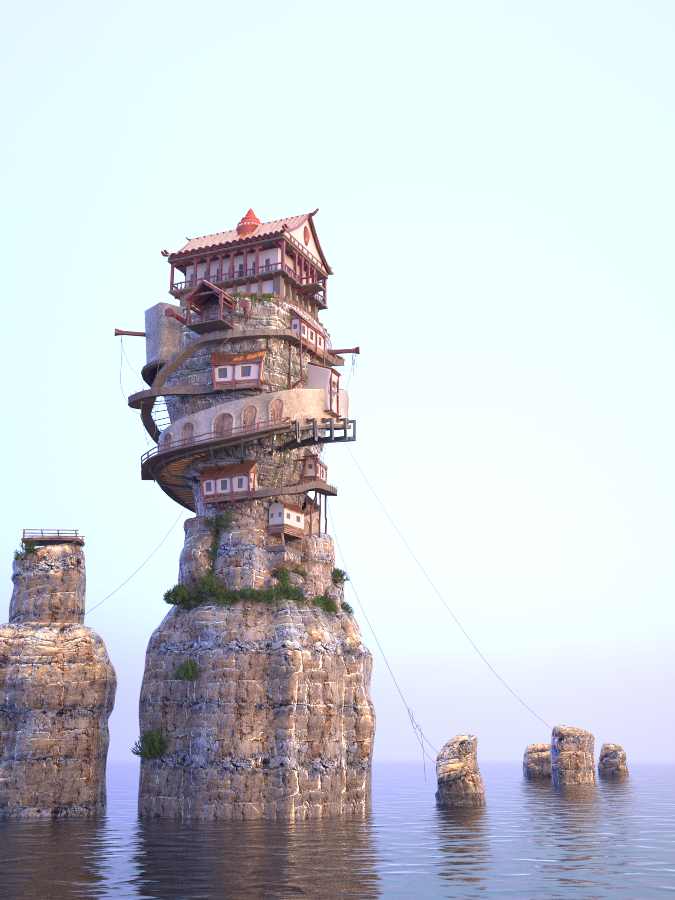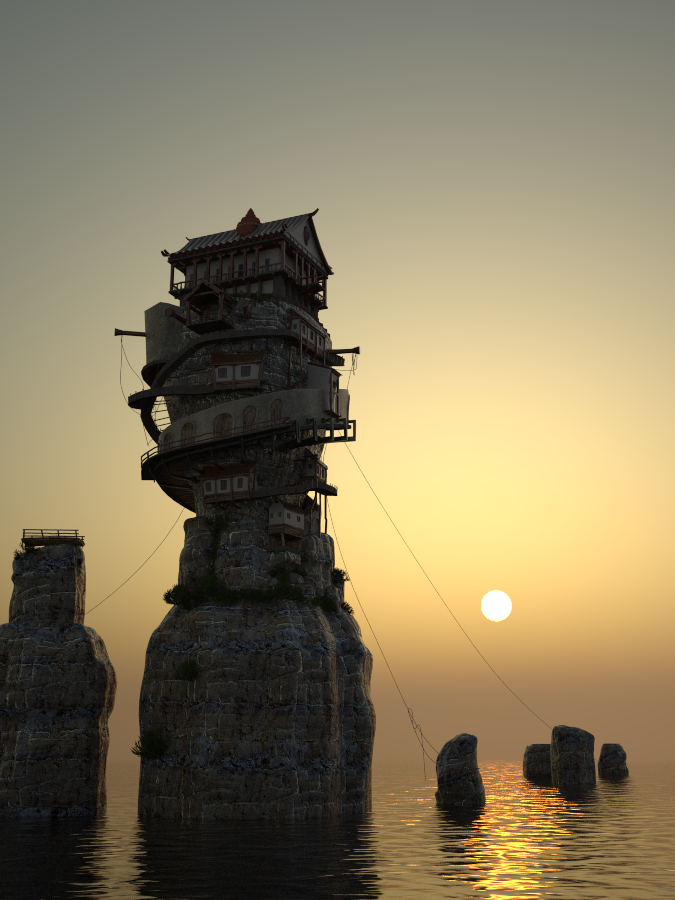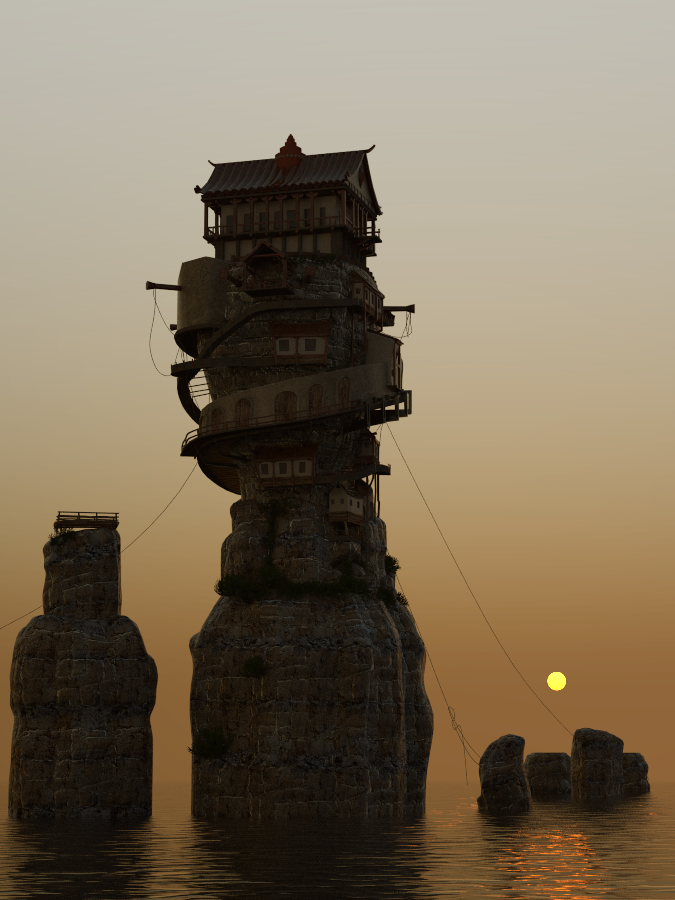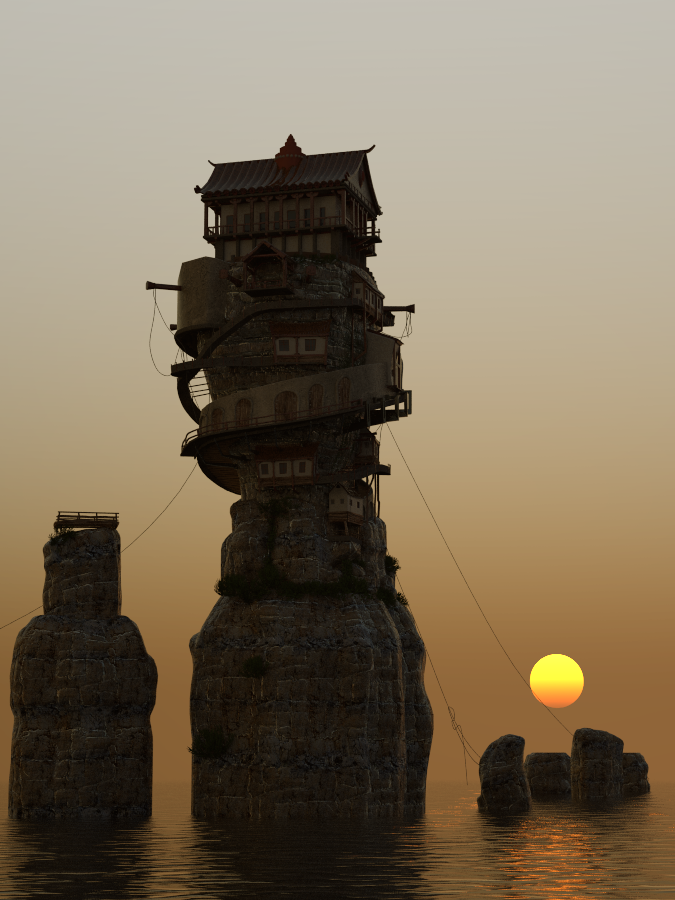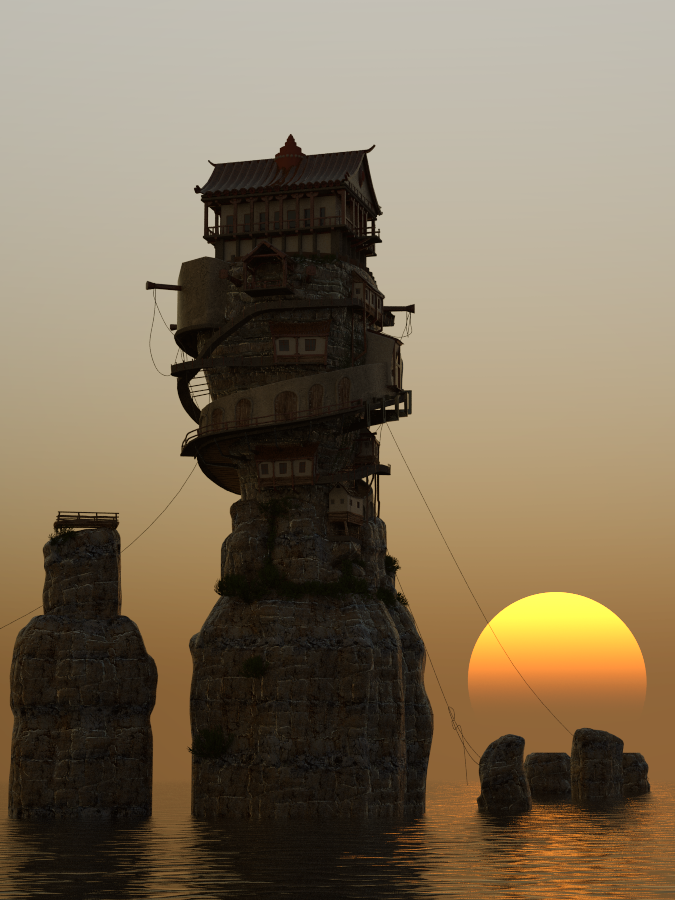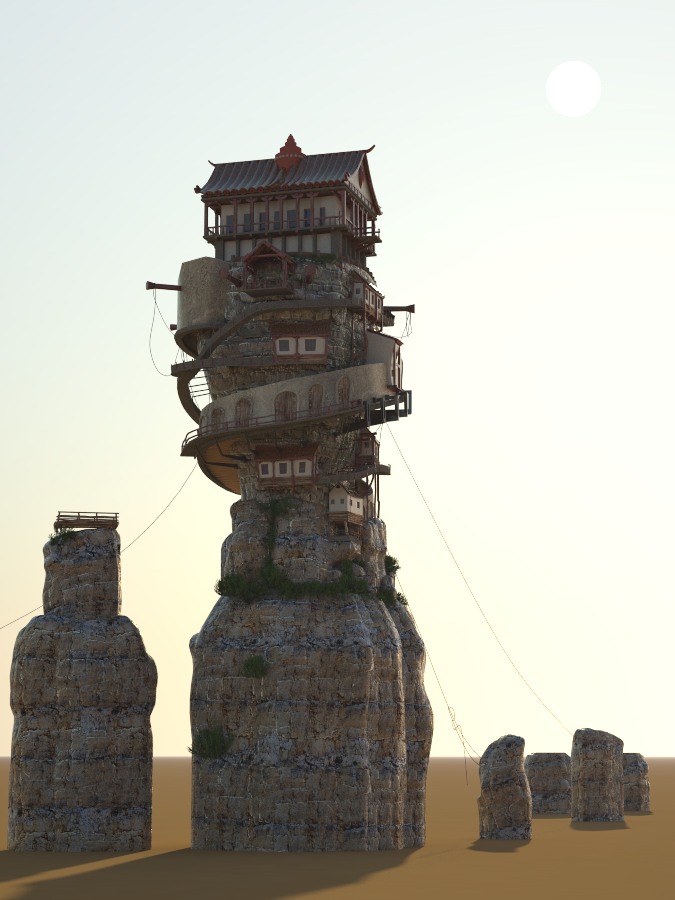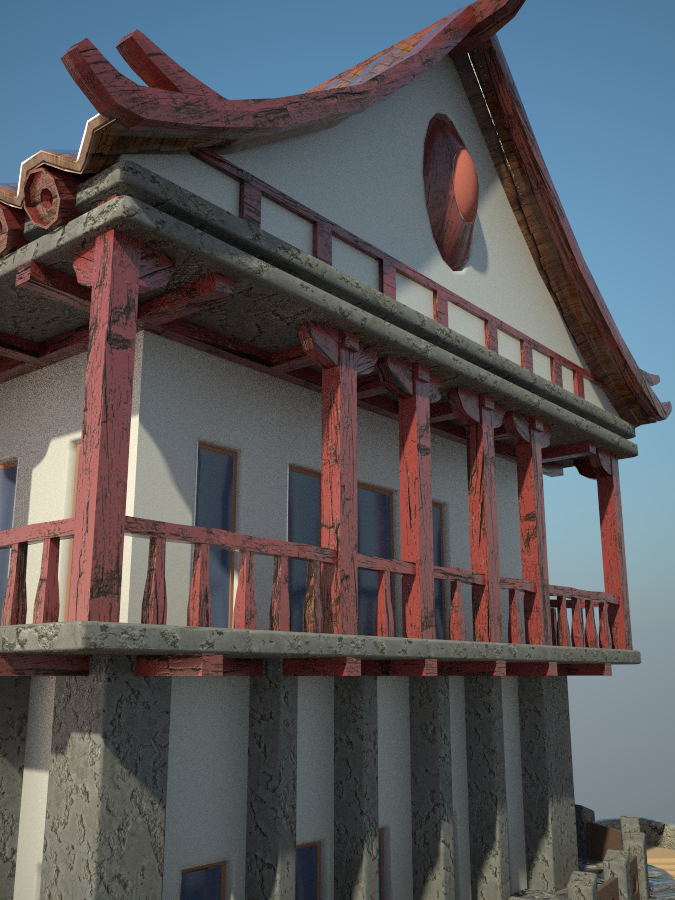This page provides information on the V-Ray Sun and Sky system.
Overview
The V-Ray Sun and V-Ray Sky are special features which are provided by the V-Ray renderer. Developed to work together, they reproduce the real-life sun and sky environment of the Earth. Both are coded so that they change their appearance depending on the direction of the V-Ray Sun.
The V-Ray Sun and Sky systems are based largely on the SIGGRAPH 1999 paper A Practical Analytic Model for Daylight [1]. For a more complete list of references, please see the Links & References section.
UI Path
||obj Network|| > V-Ray > Light > V-Ray Sun Light
||V-Ray Shelf|| > Light Sun
Main
Enabled – Turns the light on and off.
Invisible – Controls whether the shape of the Sun Light source is visible in the resulting render. When disabled, the source light is rendered in the current light color, otherwise the light source itself is not visible in the scene.
Note: This parameter only affects the visibility of the light when seen directly by the camera or through refractions. The visibility of the light with respect to reflections is controlled by the Affect Specular and Affect Reflections options.
Sky Model – Determines the procedural model used to generate the V-Ray Sky texture:
Preetham et al. – The V-Ray Sky procedural texture is generated based on the Preetham et al. method.
CIE Clear – The V-Ray Sky procedural texture is generated based on the CIE method for a clear sky.
CIE Overcast – The V-Ray Sky procedural texture is generated based on the CIE method for a cloudy sky.
Hosek et al – The V-Ray Sky procedural texture is generated based on the Hosek et al. method.
Intensity – Specifies the brightness of the sun. Since the sun is very bright by default, you can use this parameter to reduce its effect. See the Notes section for more information. For more information, see the Intensity Multiplier example below.
Size – Controls the visible size of the sun. This affects the appearance of the sun disc as seen by the camera and reflections, as well as the blurriness of the sun shadows. For more information, see the Size Multiplier example below.
Turbidity – Determines the amount of dust in the air, which in turn affects the color of the sun and sky. Smaller values produce a clear, blue sky and sun similar to what is seen in rural areas, while larger values make the sun and sky more yellow and orange as seen in a big city. For more information, see the Turbidity example below.
Ozone – Affects the color of the sun light. Available in the range between 0.0 and 1.0. Smaller values make the sunlight more yellow, while larger values make it more blue. For more information, see the Ozone example below.
Water Vapour – Controls the amount of water vapor in the atmosphere which affects the sky color .
Color – Shifts the hue of the V-Ray Sun and Sky system towards the specified color.
Color Mode – Specifies how the Filter Color affects the color of the Sun:
Filter – Shifts the hue of the V-Ray Sun and Sky system towards the color specified in the Filter Color field.
Direct – Sets the color of the V-Ray sun to match the color in the Filter Color parameter. In this case the intensity of the light does not depend on the V-Ray Suns position in the sky and is controlled through the intensity multiplier.
Override – Sets the color of the V-Ray sun to match the color in the Filter Color parameter but the intensity of the light still depends on the V-Ray Suns position in the sky.
Ground Albedo – Sets the color of the V-Ray Sun and Sky system's ground.
Horizon Offset Angle – Allows the user to manually lower the horizon line.
Horizon Blend Angle – Specifies the angle in degrees where blending occurs between the horizon line and sky. Values close to 0.0 produce a sharper horizon line, while larger values produce a softer horizon line.
Horiz. Surface Illum. – Specifies the intensity (in lx) of the illumination on horizontal surfaces coming from the sky.
Shadows
Enabled – When enabled (the default), the light casts shadows. Disable this option to turn off shadows for the light.
Atmospheric Shadows – When enabled, the sun produces shadows from volumetric effects.
Color – Sets the color of the V-Ray Sun and Sky shadows.
Bias – Moves the shadow toward or away from the shadow-casting object (or objects). Higher values move the shadow toward the object(s) while lower values move it away. If this value is too extreme, shadows can "leak" through places they shouldn't or "detach" from an object. Other effects from extreme values include moire patterns, out-of-place dark areas on surfaces, and shadows not appearing at all in the rendering. For more information, see the Shadow Bias example below.
Subdivs – Controls the number of samples for the area shadow of the Sun Light. Higher values produce area shadows with better quality but render slower. Note that this parameter is available for changing only when Use local subdivs is enabled in the DMC Sampler.
Shadow Mask – Specifies objects that cast shadows when light is directed at them.
Textures
Shadow Color – Sets the color of the V-Ray Sun and Sky shadows.
Advanced
Affect Diffuse – Determines whether the light affects the diffuse properties of the materials.
Affect Specular – Determines whether the light affects the specular of the materials. This means glossy reflections.
Diffuse Contribution – Specifies a multiplier for the effect of the light on the diffuse component.
Specular Contribution – Specifies a multiplier for the effect of the light on the specular component.
Caustics Multiplier – Specifies a multiplier for the generated caustics by the selected object. Note that this multiplier is cumulative - it does not override the multiplier in the Caustics Tab of the V-Ray Render Settings.
Caustics Subdivs – Used by V-Ray when calculating Caustics. Lower values mean more noisy results, but render faster. Higher values produce smoother results but take more time.
Photon Radius – Determines the radius of the area in which photons are shot. This area is represented by the cylinder around the Sun's ray vector. This parameter has effect when photons are used in the GI solutions or caustics.
Example: Turbidity
Turbidity creates the look of the light from the Sun having to travel through particles in the atmosphere, like smog (when the value is increased). This example shows how the Turbidity attribute is effected by the height of the V-Ray Sun in our scene. The common settings are Intensity multiplier: 1, Size multiplier: 3, while the height and Turbidity are adjusted.
Example: Ozone value
The Ozone attribute doesn't change the color of the sky, but the color of the light that hits the objects in the scene. It's a subtle effect but can help boost the photo-realism of your renders. In this example, the only thing that's adjust in the Ozone value, while the height of the sun remains the same and the following attributes are constant; Turbidity: 2.0, Intensity multiplier: 1.0, Size multiplier: 3.0.
Example: Intensity Multiplier
The Intensity Multiplier of the V-Ray Sun adjusts the brightness of it in the scene. This is also effected by the height of the Sun in the scene. To simulate the way the sun actually works, the closer the V-Ray Sun is to the horizon, the warmer the color and the less bright it will appear in the render. As you raise it up, the color will be cooler (or more blue) and the brighter it will be, like mid-day light. In the example renders below, the common settings are Turbidity: 5.0 and Size multiplier: 3.0 (which does not change the brightness), while the height (from the horizon) and Intensity Multiplier are adjusted.
Example: Size multiplier (Size & Area shadows effect)
The Size multiplier has no effect on the brightness of the V-Ray Sun. As shown early, the Intensity multiplier is adjusted to change how bright the light is coming from the Sun. The Size multiplier does however change the visual representation of the Sun when it's scene in the render and just like with other (physically accurate) lights, the larger they are, the softer the shadows are that are cast from that light. Increasing this attribute as the height of the sun is lowered can also help in the realism of your renders. In the following example, the height of the Sun and the Size multiplier are adjusted, while values for attributes like Shadow Subdivs (at 32) and Intensity multiplier (at 1.0) are constant. The first series of images show how the size of the sun is displayed in the reflection of the water. The second set shows the shadows being task on a ground plane.
Example: Shadow Bias
In the example renders below, the common settings are Shadow subdivision: 32, Intensity multiplier: 1, Size multiplier: 3.0, while the Shadow bias is the only attribute adjusted between renders. The values shown in the example are highly exaggerated to help show the effect the Shadow bias has on the scene. The change in the shadow position is most noticeable on the front of the building below the roof line where the shadow cast by the roof recedes back toward the top left overhang of the roof as the Shadow bias value increases.
Notes
- By default, the VRaySun and VRaySky are very bright. In the real world, the average solar irradiance is about 1000 W/m^2 (see the references below). Since the image output in V-Ray is in W/m^2/sr, you will typically find that the average RGB values produced by the sun and the sky are about 200.0-300.0 units. This is quite correct from a physical point of view, but is not enough for a nice image. You can either use Color Mapping bring these values to a smaller range (which is the preferred way), or you can use the Sun's Intensity multiplier to make the sun and sky less bright. Using the V-Ray Physical Camera with suitable values also produces a correct result without changing the sun and sky parameters.
Links & References
Here is a list of links and references about the V-Ray Sun and Sky implementation, as well as general information about the illumination of the Sun.
- [1] A.J. Preetham, P. Shirley, and B. Smits, A Practical Analytic Model for Daylight, SIGGRAPH 1999, Computer Graphics Proceedings;
An online version can be found at http://www.cs.utah.edu/~shirley/papers/sunsky/
This paper includes source code examples and is the base for the VRaySun and VRaySky plugins. - [2] R. H. B. Exell, The intensity of solar radiation, 2000
This page is available at http://www.jgsee.kmutt.ac.th/exell/Solar/Intensity.rtf (Please note that this link is no longer valid)
This document contains information about the average intensity of the solar radiation, as well as some specific measurements. - [3] R. Cahalan, Sun & Earth Radiation
This page can be found at http://climate.gsfc.nasa.gov/static/cahalan/Radiation/ (Please note that this link is no longer valid).
These pages contain a list of accurate solar irradiances across a large portion of the electromagnetic spectrum. - [4] D. Robinson-Boonstra, Venus Transit: Activity 3, Sun & Earth Day 2004
This document can be found online at
http://sunearth.gsfc.nasa.gov/sunearthday/2004/2004images/VT_Activity3.pdf (Please note that this link is no longer valid).
Among other things, this document gives the distance from the Sun to the Earth and the size of the Sun derived from astronomic observations. - [5] Hosek L, et al, An Analytic Model for Full Spectral Sky-Dome Radiance
This document can be found online at
http://cgg.mff.cuni.cz/projects/SkylightModelling/HosekWilkie_SkylightModel_SIGGRAPH2012_Preprint_lowres.pdf
Describes the Hosek sky model used by the VRaySun and VRaySky


